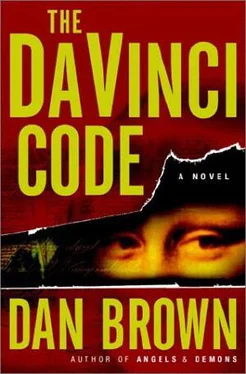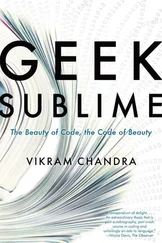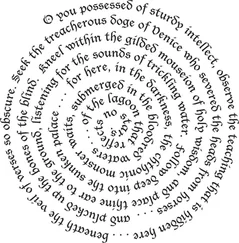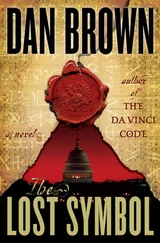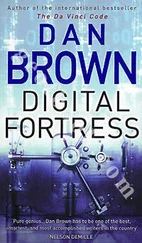Dan Brown - The Da Vinci Code
Здесь есть возможность читать онлайн «Dan Brown - The Da Vinci Code» весь текст электронной книги совершенно бесплатно (целиком полную версию без сокращений). В некоторых случаях можно слушать аудио, скачать через торрент в формате fb2 и присутствует краткое содержание. ISBN: , Жанр: Исторический детектив, Политический детектив, на английском языке. Описание произведения, (предисловие) а так же отзывы посетителей доступны на портале библиотеки ЛибКат.
- Название:The Da Vinci Code
- Автор:
- Жанр:
- Год:неизвестен
- ISBN:0-385-50420-9
- Рейтинг книги:3 / 5. Голосов: 1
-
Избранное:Добавить в избранное
- Отзывы:
-
Ваша оценка:
- 60
- 1
- 2
- 3
- 4
- 5
The Da Vinci Code: краткое содержание, описание и аннотация
Предлагаем к чтению аннотацию, описание, краткое содержание или предисловие (зависит от того, что написал сам автор книги «The Da Vinci Code»). Если вы не нашли необходимую информацию о книге — напишите в комментариях, мы постараемся отыскать её.
The Da Vinci Code — читать онлайн бесплатно полную книгу (весь текст) целиком
Ниже представлен текст книги, разбитый по страницам. Система сохранения места последней прочитанной страницы, позволяет с удобством читать онлайн бесплатно книгу «The Da Vinci Code», без необходимости каждый раз заново искать на чём Вы остановились. Поставьте закладку, и сможете в любой момент перейти на страницу, на которой закончили чтение.
Интервал:
Закладка:
Dan Brown
The Da Vinci Code
FOR BLYTHE… AGAIN. MORE THAN EVER.
ACKNOWLEDGMENTS
First and foremost, to my friend and editor, Jason Kaufman, for working so hard on this project and for truly understanding what this book is all about. And to the incomparable Heide Lange – tireless champion of The Da Vinci Code , agent extraordinaire, and trusted friend.
I cannot fully express my gratitude to the exceptional team at Doubleday, for their generosity, faith, and superb guidance. Thank you especially to Bill Thomas and Steve Rubin, who believed in this book from the start. My thanks also to the initial core of early in-house supporters, headed by Michael Palgon, Suzanne Herz, Janelle Moburg, Jackie Everly, and Adrienne Sparks, as well as to the talented people of Doubleday’s sales force.
For their generous assistance in the research of the book, I would like to acknowledge the Louvre Museum, the French Ministry of Culture, Project Gutenberg, Bibliothèque Nationale, the Gnostic Society Library, the Department of Paintings Study and Documentation Service at the Louvre, Catholic World News, Royal Observatory Greenwich, London Record Society, the Muniment Collection at Westminster Abbey, John Pike and the Federation of American Scientists, and the five members of Opus Dei (three active, two former) who recounted their stories, both positive and negative, regarding their experiences inside Opus Dei.
My gratitude also to Water Street Bookstore for tracking down so many of my research books, my father Richard Brown – mathematics teacher and author – for his assistance with the Divine Proportion and the Fibonacci Sequence, Stan Planton, Sylvie Baudeloque, Peter McGuigan, Francis McInerney, Margie Wachtel, André Vernet, Ken Kelleher at Anchorball Web Media, Cara Sottak, Karyn Popham, Esther Sung, Miriam Abramowitz, William Tunstall-Pedoe, and Griffin Wooden Brown.
And finally, in a novel drawing so heavily on the sacred feminine, I would be remiss if I did not mention the two extraordinary women who have touched my life. First, my mother, Connie Brown – fellow scribe, nurturer, musician, and role model. And my wife, Blythe – art historian, painter, front-line editor, and without a doubt the most astonishingly talented woman I have ever known.
FACT:
The Priory of Sion – a European secret society founded in 1099 – is a real organization. In 1975 Paris’s Bibliothèque Nationale discovered parchments known as Les Dossiers Secrets , identifying numerous members of the Priory of Sion, including Sir Isaac Newton, Botticelli, Victor Hugo, and Leonardo Da Vinci.
The Vatican prelature known as Opus Dei is a deeply devout Catholic sect that has been the topic of recent controversy due to reports of brainwashing, coercion, and a dangerous practice known as «corporal mortification.» Opus Dei has just completed construction of a $47 million World Headquarters at 243 Lexington Avenue in New York City.
All descriptions of artwork, architecture, documents, and secret rituals in this novel are accurate.
PROLOGUE
Louvre Museum, Paris 10:46 P. M.
Renowned curator Jacques Saunière staggered through the vaulted archway of the museum’s Grand Gallery. He lunged for the nearest painting he could see, a Caravaggio. Grabbing the gilded frame, the seventy-six-year-old man heaved the masterpiece toward himself until it tore from the wall and Saunière collapsed backward in a heap beneath the canvas.
As he had anticipated, a thundering iron gate fell nearby, barricading the entrance to the suite. The parquet floor shook. Far off, an alarm began to ring.
The curator lay a moment, gasping for breath, taking stock. I am still alive. He crawled out from under the canvas and scanned the cavernous space for someplace to hide.
A voice spoke, chillingly close. «Do not move.»
On his hands and knees, the curator froze, turning his head slowly.
Only fifteen feet away, outside the sealed gate, the mountainous silhouette of his attacker stared through the iron bars. He was broad and tall, with ghost-pale skin and thinning white hair. His irises were pink with dark red pupils. The albino drew a pistol from his coat and aimed the barrel through the bars, directly at the curator. «You should not have run.» His accent was not easy to place. «Now tell me where it is.»
«I told you already,» the curator stammered, kneeling defenseless on the floor of the gallery. «I have no idea what you are talking about!»
«You are lying.» The man stared at him, perfectly immobile except for the glint in his ghostly eyes. «You and your brethren possess something that is not yours.»
The curator felt a surge of adrenaline. How could he possibly know this?
«Tonight the rightful guardians will be restored. Tell me where it is hidden, and you will live.» The man leveled his gun at the curator’s head. «Is it a secret you will die for?»
Saunière could not breathe.
The man tilted his head, peering down the barrel of his gun.
Saunière held up his hands in defense. «Wait,» he said slowly. «I will tell you what you need to know.» The curator spoke his next words carefully. The lie he told was one he had rehearsed many times… each time praying he would never have to use it.
When the curator had finished speaking, his assailant smiled smugly. «Yes. This is exactly what the others told me.»
Saunière recoiled. The others?
«I found them, too,» the huge man taunted. «All three of them. They confirmed what you have just said.»
It cannot be! The curator’s true identity, along with the identities of his three sénéchaux , was almost as sacred as the ancient secret they protected. Saunière now realized his sénéchaux , following strict procedure, had told the same lie before their own deaths. It was part of the protocol.
The attacker aimed his gun again. «When you are gone, I will be the only one who knows the truth.»
The truth. In an instant, the curator grasped the true horror of the situation. If I die , the truth will be lost forever. Instinctively, he tried to scramble for cover.
The gun roared, and the curator felt a searing heat as the bullet lodged in his stomach. He fell forward… struggling against the pain. Slowly, Saunière rolled over and stared back through the bars at his attacker.
The man was now taking dead aim at Saunière’s head.
Saunière closed his eyes, his thoughts a swirling tempest of fear and regret. The click of an empty chamber echoed through the corridor. The curator’s eyes flew open.
The man glanced down at his weapon, looking almost amused. He reached for a second clip, but then seemed to reconsider, smirking calmly at Saunière’s gut. «My work here is done.»
The curator looked down and saw the bullet hole in his white linen shirt. It was framed by a small circle of blood a few inches below his breastbone. My stomach. Almost cruelly, the bullet had missed his heart. As a veteran of la Guerre d ’ Algérie , the curator had witnessed this horribly drawn-out death before. For fifteen minutes, he would survive as his stomach acids seeped into his chest cavity, slowly poisoning him from within.
«Pain is good, monsieur,» the man said. Then he was gone. Alone now, Jacques Saunière turned his gaze again to the iron gate. He was trapped, and the doors could not be reopened for at least twenty minutes. By the time anyone got to him, he would be dead. Even so, the fear that now gripped him was a fear far greater than that of his own death.
Читать дальшеИнтервал:
Закладка:
Похожие книги на «The Da Vinci Code»
Представляем Вашему вниманию похожие книги на «The Da Vinci Code» списком для выбора. Мы отобрали схожую по названию и смыслу литературу в надежде предоставить читателям больше вариантов отыскать новые, интересные, ещё непрочитанные произведения.
Обсуждение, отзывы о книге «The Da Vinci Code» и просто собственные мнения читателей. Оставьте ваши комментарии, напишите, что Вы думаете о произведении, его смысле или главных героях. Укажите что конкретно понравилось, а что нет, и почему Вы так считаете.
